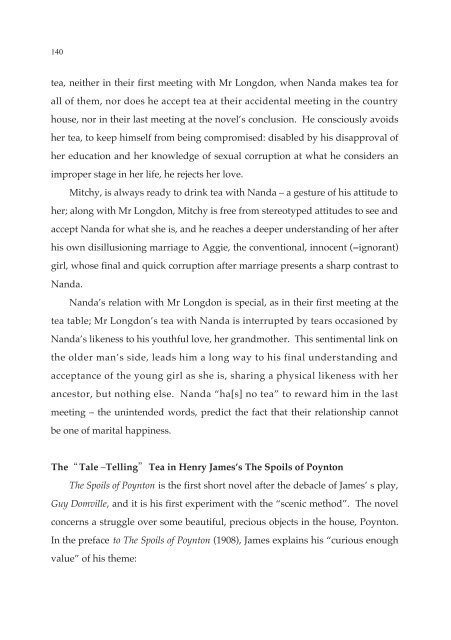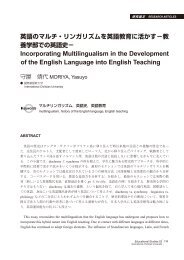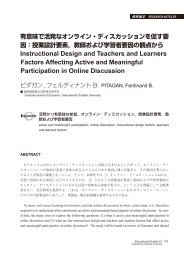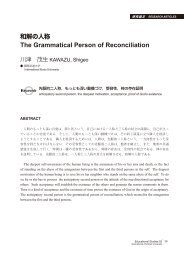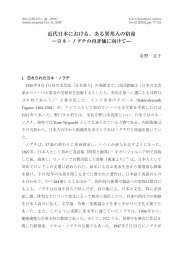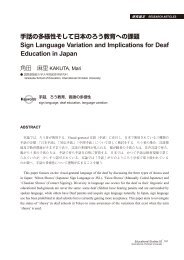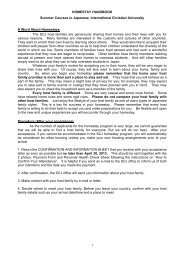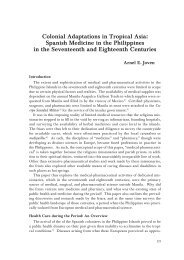Tea and Henry James's 'Scenic Method' in The Awkward ... - subsite
Tea and Henry James's 'Scenic Method' in The Awkward ... - subsite
Tea and Henry James's 'Scenic Method' in The Awkward ... - subsite
Create successful ePaper yourself
Turn your PDF publications into a flip-book with our unique Google optimized e-Paper software.
140<br />
tea, neither <strong>in</strong> their first meet<strong>in</strong>g with Mr Longdon, when N<strong>and</strong>a makes tea for<br />
all of them, nor does he accept tea at their accidental meet<strong>in</strong>g <strong>in</strong> the country<br />
house, nor <strong>in</strong> their last meet<strong>in</strong>g at the novel’s conclusion. He consciously avoids<br />
her tea, to keep himself from be<strong>in</strong>g compromised: disabled by his disapproval of<br />
her education <strong>and</strong> her knowledge of sexual corruption at what he considers an<br />
improper stage <strong>in</strong> her life, he rejects her love.<br />
Mitchy, is always ready to dr<strong>in</strong>k tea with N<strong>and</strong>a – a gesture of his attitude to<br />
her; along with Mr Longdon, Mitchy is free from stereotyped attitudes to see <strong>and</strong><br />
accept N<strong>and</strong>a for what she is, <strong>and</strong> he reaches a deeper underst<strong>and</strong><strong>in</strong>g of her after<br />
his own disillusion<strong>in</strong>g marriage to Aggie, the conventional, <strong>in</strong>nocent (=ignorant)<br />
girl, whose f<strong>in</strong>al <strong>and</strong> quick corruption after marriage presents a sharp contrast to<br />
N<strong>and</strong>a.<br />
N<strong>and</strong>a’s relation with Mr Longdon is special, as <strong>in</strong> their first meet<strong>in</strong>g at the<br />
tea table; Mr Longdon’s tea with N<strong>and</strong>a is <strong>in</strong>terrupted by tears occasioned by<br />
N<strong>and</strong>a’s likeness to his youthful love, her gr<strong>and</strong>mother. This sentimental l<strong>in</strong>k on<br />
the older man’s side, leads him a long way to his f<strong>in</strong>al underst<strong>and</strong><strong>in</strong>g <strong>and</strong><br />
acceptance of the young girl as she is, shar<strong>in</strong>g a physical likeness with her<br />
ancestor, but noth<strong>in</strong>g else. N<strong>and</strong>a “ha[s] no tea” to reward him <strong>in</strong> the last<br />
meet<strong>in</strong>g – the un<strong>in</strong>tended words, predict the fact that their relationship cannot<br />
be one of marital happ<strong>in</strong>ess.<br />
<strong>The</strong>“Tale –Tell<strong>in</strong>g”<strong>Tea</strong> <strong>in</strong> <strong>Henry</strong> James’s <strong>The</strong> Spoils of Poynton<br />
<strong>The</strong> Spoils of Poynton is the first short novel after the debacle of James’ s play,<br />
Guy Domville, <strong>and</strong> it is his first experiment with the “scenic method”. <strong>The</strong> novel<br />
concerns a struggle over some beautiful, precious objects <strong>in</strong> the house, Poynton.<br />
In the preface to <strong>The</strong> Spoils of Poynton (1908), James expla<strong>in</strong>s his “curious enough<br />
value” of his theme:


